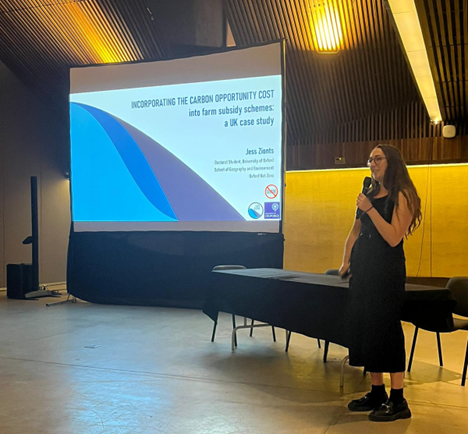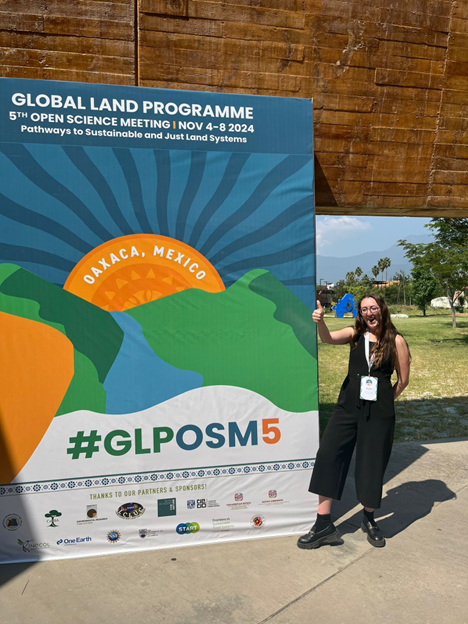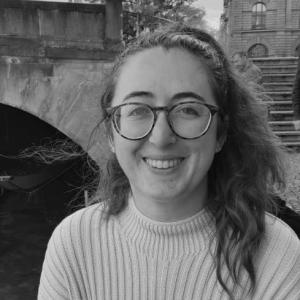With a strong urge to see equitable sustainability and as a young American looking for inspiring political leadership, a DPhil student at the Environmental Change Institute reflects on an eventful week she recently experienced, which included presenting her research at a global conference. Jess Zionts explains…

From November 4th to 7th, the Global Land Programme (GLP) hosted over 800 scientists from over 50 countries in Oaxaca, Mexico for their 5th Open Science Meeting on ‘Pathways to Sustainable and Just Land Systems’. As a third-year DPhil student, I had the opportunity to present my research at a conference for the first time, which felt like a significant milestone in my career. I also did my best to make the most of a long journey by creating connections with peers and mentors alike. Here, I share my experience and takeaways of the meeting to shed some light on what was, overall, a very positive and productive week.
Of course, the GLP was not the most consequential global event of the week with the unfortunate unfolding of the U.S. Election. As an American, I found my emotions to be split. On the one hand, the results left me with a certain irony about being at a conference centered on justice and sustainability on a day which represented a dramatic shift away from both values for my country. On the other hand, to be surrounded by hundreds of people fully dedicated to positive and transformative change helped to restore my sense of hope for the future.
Before the conference, I spent Dia de los Muertos (‘Day of the Dead’ predominantly Mexican holiday) in Mexico City which was a thrilling experience. This was followed by the conference’s kick-off party in Oaxaca on Monday night. We met in the Plaza de Santo Domingo, a cultural center of the city, where we were treated to a traditional Oaxacan Calenda. A Calenda is a parade involving live music, giant puppets, and ornately dressed dancers. The procession made its way through the streets to a venue where chapulines (crickets, an Oaxacan delicacy) and mezcal flowed. This event set a joyful and vibrant tone for the rest of the week.
The Opening Plenaries on Tuesday morning were chaired by the GLP’s Scientific Steering Committee, Rachael Garrett from Cambridge and Navin Ramankutty from the University of British Columbia. They introduced the GLP’s Science Plan, a five-year high-level strategy for the future of Land Systems Science (LSS). They also highlighted the three key themes of the meeting: The State of the World, Imagining the Future(s), and Enabling Transformative Changes.
Through this plenary session, it became clear to me just how unique this confluence of expertise was, and what a privilege it was to be able to attend such a conference. LSS as a field is fundamentally inter-disciplinary, ranging in subject matter from conservation ecology to complexity modeling, and geopolitics to smallholder farming. Choosing which of the 100+ sessions to attend was a challenge in itself.
A chance to challenge new thinking
The Plenary keynote speakers included Eduardo Brondizio from Indiana University, Meha Jain from the University of Michigan, and Pedro Brancalion from the University of Sao Paolo. These speakers presented a wide range of technical and socio-economic perspectives on the cross-cutting challenges associated with the conference themes.
One of these keynote talks caught my attention, entitled ‘Ecosystem restoration will increase the demand for land: Concerns and opportunities for sustainability.’ This is a sentiment that resonates with me—land is finite, and taking agricultural land out of production for nature restoration can add to global pressures to convert more land for human uses. I was therefore surprised when the speaker explained how their initiative purchased ‘degraded land’ in the Amazon to restore through tree planting in an apparently contradictory manner to the premise of the presentation. An Indigenous Mexican attendee then provocatively asked whether the presenter saw their actions as perpetuating the dispossession of Indigenous land, garnering a round of applause from the audience.
This exchange highlights one of the core equity challenges when it comes to LSS which sits at the center of my research: land isn’t free, both in a monetary sense, but also in terms of the additionality of carbon storage due to the reality of global land use competition. When the Global North turns to the biosphere of the Global South to offset emissions, these problematic transactions are incentivized.
On a similar note, I met (and verbally jousted with) several employees of various carbon credit schemes at the conference, and dug up the courage to press them on the many well-established issues associated with their methodologies. When I relayed my experiences to fellow academics or non-profit researchers, they generally expressed solidarity with my efforts to challenge the presence and actions of these companies. As one colleague expressed, “it has been a hard week for the [carbon credit scheme representatives].”

Seeking a path forward
This conference was about more than going to battle against the voluntary carbon market, though. In only four days, I managed to have many rich discussions with many senior researchers with whom I’ve corresponded only online. I also connected with many PhD students and early-career researchers (ECRs) doing similar work, and even recruited some potential collaborators for the final chapter of my thesis. It was particularly refreshing to see that, in the majority of the research sessions, PhD students and ECRs had a strong presence on the stage. To see such a distinguished conference with high-profile members center and celebrate the work of young people was inspiring and appreciated.
I attended a number of engaging presentation sessions on land use modelling, private sector supply-chain initiatives, and an interactive session about ‘Climate Action on Land.’ At this interactive session, attendees discussed how to catalyze transformative change while managing trade-offs in Land Systems in small groups. When it came time to share what we discussed, one attendee said that “we can’t make people have to care.” In other words, we must pull socio-economic policy levers to make the most economically viable option for individuals the most sustainable decision. For example, people will continue to buy meat if it’s the most affordable option, so we must generate incentives to encourage large-scale shifts towards lower-impact decisions.
While this quote certainly comes off as rather pessimistic and apathetic, for me, it encapsulates the core challenge underpinning the three themes of the conference: how can society make progress towards a more just and sustainable world within the bounds of modern capitalism? Considering this quote, the path forward becomes clear, albeit complicated. It is clear in the sense that we know corporate and government entities around the world must step up to prioritize ambitious mitigation of emissions and halt native ecosystem loss through interventions such as subsidy reform such that the sustainable choice becomes the easy choice.
It is complicated because, today, the decision-makers of the world haven’t shown they are willing to pursue meaningful shifts in the status quo, and that business-as-usual is still the easier option.
Find out more about the Global Land Programme, and watch recordings of some of the sessions.

